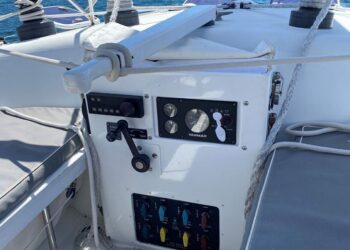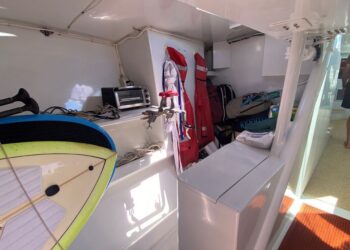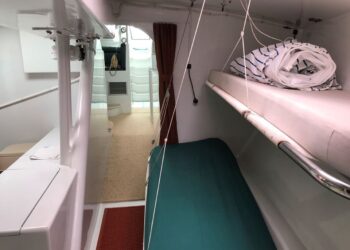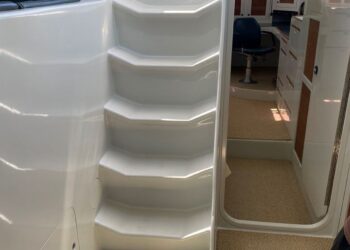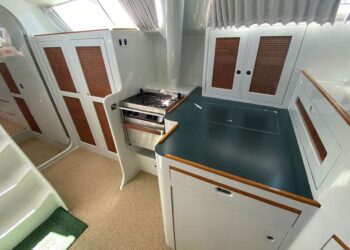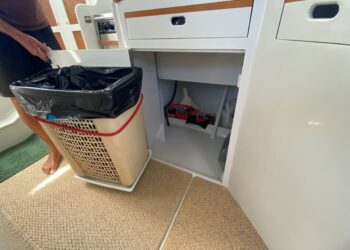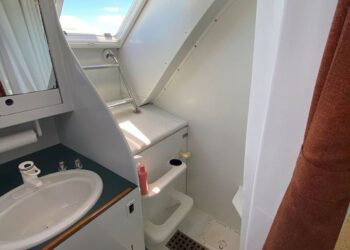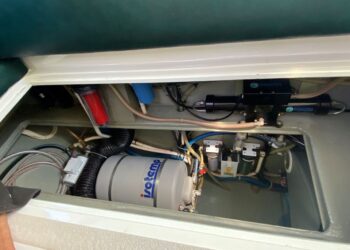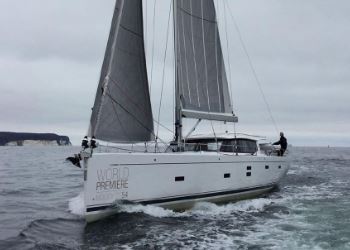Your Local Broker, Internationally
Berthon UK
(Lymington, Hampshire - UK)
Sue Grant
sue.grant@berthon.co.uk
0044 (0)1590 679 222
Berthon Scandinavia
(Henån, Sweden)
Magnus Kullberg
magnus.kullberg@berthonscandinavia.se
0046 304 694 000
Berthon Spain
(Palma de Mallorca, Spain)
Simon Turner
simon.turner@berthoninternational.com
0034 639 701 234
Berthon USA
(Rhode Island, USA)
Jennifer Stewart
jennifer.stewart@berthonusa.com
001 401 846 8404
Broker’s Comments
A one-of-a-kind couple’s dream machine, fast cruising yacht with a long list of unique features. One of the key features is the yacht’s all carbon construction by one of the world’s best carbon performance boat builders, Eric Goetz of Bristol RI.
Another key feature of ROUTE 66 is the pristine condition the original builders/owners have kept her in. A rare opportunity to own an all carbon, stable, safe and performance oriented, and self-sufficient cruising yacht.
Note
Offered to co-brokers on a commission split of 50/50.
Owner’s Comments
ROUTE 66 is a consummate blue water cruising yacht. Extremely comfortable at sea with smart seamanship, she is quite a unique combination of size, manageability, and liveaboard fun. This is due to her relatively light displacement, a center cockpit, the B&R rig, the clean deck, interior and systems layouts and simple dingy access. Her length provides both speed and comfort, while the absence of paid crew allows for complete privacy, economy and and freedom from management issues.
Many unique design features that are not present on other boats of similar size make this 70-footer easy to maintain and comfortable for a cruing couple. My wife and I have owned her since she was launched in July 1993. We lived on board full time for the first 8 years and for extended summers and a modest amount of winter sailing each year subsequently. We have sailed her over 100,000 nautical miles as a couple, including two trans-Atlantic passages, winter in the Caribbean and more than a dozen offshore trips from Florida to the Bahamas, to New England and back. We have been as far north as the Bras D’Or Lakes and the UK/England, and as far south as Gibraltar in the EU and Grenada in the Caribbean. We have ridden out multiple hurricanes or severe storms in mangrove swamps, rivers, coves, and bays, and almost exclusively on our own anchors while we were on board.
ROUTE 66 has a relatively large keel chord as well as a deep keel when it is down. This large keel area, while less than ideal for racing, allows us to go relatively slowly without stalling, and adds to comfort at anchor by reducing and slowing any roll. The keel sits in a very robust housing and is held in place by a single large pin. It is raised and lowered by a second pin connected to two powerful hydraulic rams. Having a 6.0ft. (keel up) draft on this large of a monohull sailboat is extremely unusual and allows us to access and explore areas off limits to most yachts of similar size or performance. Overall, the keel arrangement is a very simple system that makes it easy to remove the keel and gives the option of other shapes and drafts if desired. For example, it would be extremely easy to remove the existing keel and keel hydraulics and insert a fixed T or L shaped keel of any depth.
In view of its size and performance, ROUTE 66 is very economical to sail and live aboard. The yachts’ spaciousness allows easy access to all systems (power, electrical, plumbing, instrumentation, sailing, etc.). Light displacement results in lighter loads and smaller hardware. One reasonably capable sailor, having all systems manuals handy, along with the right tools and spare parts, pretty much can fix anything on the move and maintain all systems to top standards. Personally, we have always focused on structural, mechanical, and electrical perfection, dealing with cosmetics secondarily. Keeping all enclosed spaces clean and dry has contributed greatly to equipment longevity, the early recognition of any problem, and ease of maintenance. This has been made easier because all surfaces are “finished” and painted, even the bilges.
Construction is essentially all carbon fibre/epoxy composite (hull, interior furnishings, keel, rudder, mast boom and rigging). In addition, despite being quite light for a cruising boat of her size, she is quite conservatively overbuilt. The result is that after 28 years of use, she is structurally rock solid with zero stress cracks or core issues of any kind. Considering the essentially unlimited cyclical wear of carbon fibre construction, with reasonable care she will outlive all her owners and their children’s children! The hull was designed with a 45-degree “breakaway” bow bulkhead with a large sacrificial nose and forward waterline area to prevent a hull breach in the event of a major UFO collision at sea. This angled bulkhead is backed up further by a watertight bulkhead with a solid hatch in the forepeak. There is also a major watertight bulkhead aft of the aft cabin area to thwart any possible water intrusion from the very unlikely scenario of damage to the stern dingy garage or lazarettes.
ROUTE 66 has a very narrow waterline and virtually every section is an arc of a circle. The consequences of this are that she is very slippery, wants to go in a straight line even when heeled, has zero tendency to broach, and is easy to steer, but has essentially no form stability. All stability is created by a low center of gravity from the keel and equipment installations, and a wonderful set of movable ballast systems that contribute immensely to comfort and performance. Extensive tanks in the flared hull sides allow 1,500 lbs. of transferable diesel fuel capacity and the ability to intake, discharge, and transfer over 3,500 lbs. of seawater that takes full advantage of her 19ft beam. The practical effect of this is that we can sail her essentially flat and add considerable mass/inertia for powering through waves when necessary or desirable. Also, since the hull form is so easily driven, we can sail at high speeds using an “underpowered” amount of sail area. In bad weather, for example, we might decide to sail flat (0 to 10 degrees of heel) on the wind or close reaching at 8-9 knots with shortened sail area when we could be sailing at 10-12 knots if we powered up and heeled at 10-25 degrees. Off the wind, we always sail flat at a broad wind angle and speed is directly proportional to sail power. Under engine, we cruise at 9.5 to 10 knots burning about 3 gallons/hr of diesel.
We designed the boat and systems for a live-aboard couple with the intent that we could go long periods (months) without coming to a dock. A very large fuel capacity, watermaker and very efficient 4.2kw, fresh water-cooled, AC generator are essential components for this purpose. We have not added solar, wind or waterpower charging systems since we have never come close to running out of fuel. Fast charging Lithium-ion batteries allow minimum generator run times unless we are using the heat or air conditioning.
Lately we have been cruising New England every summer to be near the grandchildren. Therefore, we have not been using the watermaker. We go to a water dock about every two weeks and also do a pump-out. Our anchoring system is excellent, and it is not unusual for us do the entire summer without spending a single night at a dock or mooring.
We have no concerns about our dingy being stolen or the painter getting caught in the prop, or bad weather swamping it, because we always keep it in the dingy garage every night and when moving. This also keeps the dingy bottom clean without the need of bottom paint since it is above the waterline when inside. We have lines that pull it in and pull it out that are accessible from the fold down transom step. This is a simple manual task that takes less than two minutes. There is a gasoline fueling station (30 gal.) in the port lazarette.
Some details that we insisted upon when doing the deck design was that there be no exposed wood (for ease of maintenance), and that there be no objects on deck that could come loose when sailing. Therefore, the decks are clean and maintenance free, and practically every toy that you could want for cruising has a place below deck. The decks are slightly cambered or angled and the cockpit designed so there is no possibility of standing water regardless of weather or heel angle. The aft deck is a large area that is ideal for setting up water activities (diving, kiting, paddle boarding, etc.). The folding step provides perfect access to the water surface. It is flanked by very large port and starboard lazarettes with interior lighting and sufficient space to stand or sit. One can safely/easily work in them in bad weather and at sea if the need arises. We keep a spare, transom mounted, all carbon composite, modular rudder, and independent steering system in the lazarettes for the unlikely event of catastrophic damage to the primary rudder.
ROUTE 66 is tiller steered. Tiller steering is permanently mounted in the cockpit and available from the aft deck. The folding and extendable cockpit tiller allows the cockpit to be both cozy and more open for comfort. The neutral buoyancy transom hung rudder provides the maximum leverage for steering, and the hull shape is extremely directionally stable. We have never seen sea conditions that the autopilot couldn’t handle with ease since we added the rate gyro to the system. We use the electric autopilots virtually all the time we are moving except when manoeuvring in harbor/traffic and when steering for pleasure. One autopilot drives the tiller quadrant and there is a separate autopilot for the trim tab on the rudder. Either can be controlled from the cockpit or the nav station below. Both pilots are highly reliable and located in protected areas. They are very powerful and run on independent rams.
ROUTE 66 has a transom hung rudder because of the canting feature that provides access to the dingy garage, it allows a smaller than normal rudder area and for simplicity of maintenance. A nice safety advantage of the transom hung rudder over a typical spade rudder configuration is that there is no chance that collision of the rudder with an underwater object could sink the boat.
One can raise, lower, and reef the mainsail, and furl/unfurl the working jib without leaving the center cockpit. This is a major safety feature in adverse weather and sea conditions. These working sails also provide plenty of power in typical sailing conditions for cruising, making sailing as simple as you wish. The Code 0 and spinnaker are huge speed boosters when desired. The center cockpit is designed with two 4-inch diameter drains to assure that it is never flooded. The two benches can be canted to suit a sustained angle of heel and are large enough to sleep on if desired. This center cockpit is perfectly located for visibility, protection from spray and the weather and communication with a person below.
The tripod on deck is the most unusual feature of the very powerful rig. It is a straightforward engineering solution to the normally complicated load distribution problems of typical sailboats that is created by a fully tensioned rig driving the mast down in the middle while pulling from both sides and both ends of the boat, basically working to bend the entire hull. On ROUTE 66, these loads are all linearly distributed internally within the tripod and standing rigging alone and not into bending the hull. This allows for a very open interior and lighter weight hull structure. The well proven B&R rig is intended to have no backstay or running backstays normally found on a boat/rig of this size. Thus, she can carry a very large roach on the mainsail while having zero risk of rig damage from an accidental jibe or missed timing with runners. Tacking or jibing requires fewer hands, and there is reduced windage and cordage clutter in the cockpit area. The B&R rig is tensioned by tightening the forestays and is extremely durable because none of the standing rigging elements goes slack under load. The compromises associated with the rig are: 1) that the mast shape (prebend) is fixed (actually this is an excellent safety feature!), so that all mainsail shape adjustments while sailing must be done with the halyard, cunningham and at the clew, and 2) that the boom may only be let out 60 degrees off the centerline, so projected sail area is slightly reduced when sailing dead downwind. In practice, neither of these creates a problem and the advantages for shorthanded sailing are huge. The boom is fully and very safely controlled by a fixed vang and a dual mainsheet arrangement that eliminates the need for a traveler. The single line mainsail reefing system works well on any point of sail.
Many cruising boats of similar or smaller size have a master suite forward to have privacy and space for a large double bunk. In our opinion, this is the worst possible place for a comfy stateroom. Water noise, wind noise and motion, not to mention nearby sail and chain lockers, and poor airflow because of need for watertightness forward all contribute to a difficult environment for comfort. On ROUTE 66, the master double bed is centered very near the axis of pitch and roll and is a very peaceful and easily ventilated spot. The seas can be chaotic and the wind howling, and a peaceful night sleeping will be found there at sea or at anchor. When sailing in heeled or rough conditions, adjustable, paired, double lee cloths make this bed even cozier.
We are terminally opposed to seawater flush heads. They foul quickly, smell bad all the time and are horribly unpleasant to maintain. Therefore, we have a freshwater system on ROUTE 66. For flushing we have the option of using water directly from the potable water supply or using gray water from the shower sump. In practice, there is always enough gray water for our flushing requirements. The system is an electric LAVAC type with manual override available that is heavily modified with custom parts for ease of maintenance and reliability. Also key is that the head is forward facing and boxed-in so that it is comfortable and secure for the user on either tack even when heeled.
The interior is designed to avoid the cave-like atmosphere of most performance monohulls and to keep all things required for daily living within easy reach. It can be made bright with direct daylight in every area and allow living and sailing in cozy, dry and convenient spaces where you are fully protected from the elements outside. “Blackout” curtains and sunscreens for the hatches readily slide in place to create darkness for sleeping or shield from the sun as needed. The nav station is incorporated into the galley and seating areas so that there is no isolation while preparing meals, eating, navigating, and sailing the boat. 270+ degree views from wherever you are sitting or standing while in the main living area make these activities low anxiety, congenial and allow a pleasant routine on passages. Currently the forward cabin is open and simply partitioned. The centerline low is occupied by chain and rope lockers. To starboard are shelves and a workbench and a small platform for a Porta-Pottie, useful for emergencies. To port are two canting pipe berths. This area could easily be modified into a spacious formal second head and private cabin for two people or children. Forward is a large area for sail/beanbag storage to port and a surfboard/paddleboard rack to starboard.
I could ramble on, describing the smaller details that enhance life aboard and the sailing experience, but would still forget to mention many things that make this a special yacht. Seeing it firsthand is really the only way to get a grasp on this unique boat.
Yacht Details
- Builder: Eric Goetz Custom Yachts
- Model: Custom B&R / Eric Goetz 68
- Yacht Name: ROUTE 66
- Hull Designer: Bergström & Ridder
- Year Built: 1993
- LOA: 68’4” / 20.84m
- LWL: 66’8” / 20.32m
- Beam: 19’5” / 5.93m
- Min Draft / Max Draft: 6’ / 1.83m
- Displacement: 14,288kg / 31,500lb
- Berths: 4 berths in 2 cabin(s) / 1 head/WC(s)
- Engine Count: 1 Yanmar 4JH4-HTE (110hp) Diesel
- Country: Chesapeake, VA, USA
- Asking Price: US$650,000
Contact Details
Peter Houghton
Berthon USA
Tel: +1 401 846 8404
E-Mail: peter.h@berthonusa.com
Click image for full broker profile.
Your Local Broker, Internationally
Berthon UK
(Lymington, Hampshire - UK)
Sue Grant
sue.grant@berthon.co.uk
0044 (0)1590 679 222
Berthon Scandinavia
(Henån, Sweden)
Magnus Kullberg
magnus.kullberg@berthonscandinavia.se
0046 304 694 000
Berthon Spain
(Palma de Mallorca, Spain)
Simon Turner
simon.turner@berthoninternational.com
0034 639 701 234
Berthon USA
(Rhode Island, USA)
Jennifer Stewart
jennifer.stewart@berthonusa.com
001 401 846 8404











